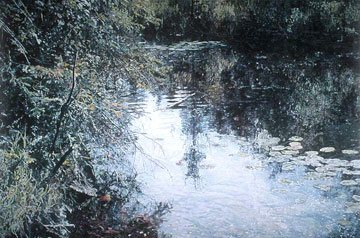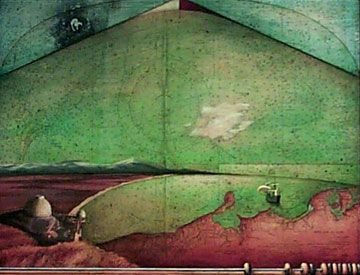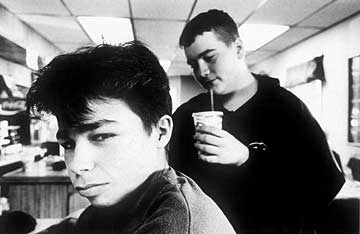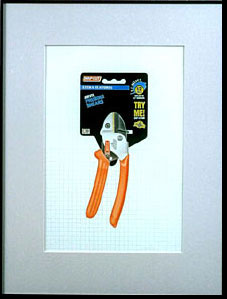 |
WILLIAM NICHOLS
Inland Brook - 2000
oil on linen
55 x 83 inches (139.7 x 210.82 cm)
William Nichols William A. Nichols' paintings can be described, paradoxically, as gestural Photo-Realist works. Photo Realism's flawless imitation in paint of a photographic sur-face leaves little room for the gesture, but this contradiction is resolved quite successfully in Nichols' paintings. The artist takes his own photographs, mainly of subjects in parks and botanical gardens in the Milwaukee area, and works from a slide projected on his canvas. The rapid, gestural application of transparent mixtures of acrylic paint suggests the spontaneity of Impressionist technique but the photo reference here is unmistakable. The color in his landscapes often has a slight overall tint which suggests the distortion common in color slides, and "overexposed" light areas and 'underexposed" dark portions serve as compositional elements in the paintings. Acrylic watercolor is not the usual medium of Photo-Realist canvases, and Nichols' surfaces differ accordingly. The clarity of his paint is especially appropriate to the depiction of the foliage, flowers, and white-aired spaces that are his subjects; the light translucence of the paint itself suggests the freshness of the natural subject matter. The overwhelmingly lush and extravagant visuals sometimes delay perception of the formal elements of the compositions, but Nichols best paintings are vigorous and sophisticated compositions of both structure strength and subtlety. Excerpt from Catherine Lamagna Arts Magazine, September 1979 Artist Statement: Verbalizing about the visual arts is always a difficult task that usually falls short of the mark. It is a domain of ambiguities and a job that's made even tougher when talking about your own work. So with this in mind let me do my best and say that I use the landscape for what it is capable of generating; great beauty, sensuality and a sense of time. I have pursued these qualities through looking at landscape--close up as opposed to a traditional vista or distanced viewpoint. The peculiar sense of intimacy that this achieves, I have tried to heighten through the large scale of work and by handling the paint in a way that imparts a sensual and tactile awareness of surface at close range. The photograph is an important component in constructing the painting. Its ability to lock in quantities of information at a precise moment in time and report candidly about it offers a unique vantage point from which to explore and reflect on things with a new kind of thoroughness. The photograph helps me create a view from a distance that has great pictorial clarity with an attempt to place the spectator in the landscape, that is, trying to create a sense of being surrounded by it rather than approaching it frontally. Because of the inate beauty of the subject matter itself, the underlying toughness or edge of the work is not as obviously accessible as it is in other works which focus more directly on this aspect. Finding a form or path of constructing the painting that both includes this beauty yet transcends the sentimental and pretty which the subject matter could easily become, is a major challenge and one which I hope I have been successful in overcoming. Frankly, it is difficult to speak directly about the content or poetry of the work. Suffice it to say that it is of great importance to me and available for the viewer to experience and define for him or herself. William A. Nichols, 1991
 |
ROBERT
VAN VRANKEN
Untitled (Waiting For Icarus-After Breughel) - 2003
oil and mixed media on board
15.5 x 19.75 inches (39.37 x 50.16 cm)
Robert Van Vranken "These paintings are a synthesized collage of mistakes. That is, there was never a master plan and if there was no one ever took it seriously...these paintings are simply a record, and perhaps even a synthesis, of billions of infinite small moments; moments of sleepiness and moments of wide-awakeness; moments of clarity and of confusion; moments of hoping for something and moments of fearing everything; moments with music and moments without music; moments of abandon and moments of control -- but all moments identical in dimension to the moment in which you now stand, your shoes pushed down hard against the floor." Robert Van Vranken 1999 These paintings are made in much the same way a plaster wall is constructed. First, 3/4" plywood panels are covered with wire mesh and then painted with a covering of latex liquid bonding agent (Weld-O-Bond) - this helps to bond the subsequent layers of plaster to the board. Nest the first coat, or 'scratch coat' of plaster is applied with a notched trowel. For this first coat a perilited gypsum plaster called "Gypsolite" is used -this creates a good rough surface for the nest coat and is also light in weight After this coat dries the surface is again coated with latex liquid bonding agent and then given a second coat of plaster - this time a standard plaster made with 50% gauging plaster and 50% slaked time. The surface is troweled to a desired finish. After the plaster dries, usually a couple of days, oil paint can then be applied. In some areas additional layers of plaster are added, or previous layers are sometimes removed with a chisel. The painting becomes a slow cumulative process of the addition and subtraction of plaster, paint and collage materials. The intent of the process is never clearly known "Inside these paintings, one has the feeling that time has passed, that lives have been lived here, that ideas and events have come and gone, that things have changed. What remains is a kind of tracery of the passage of time, and the enormous sound of its silence. After the storm of time, what remains are not the specifics of each intention, each thought, or each act, but rather some kind of pure distillation of the energy of change itself - a distillation which renders this small piece of plywood whole, complete, beyond the need to measure." - Anonymous There is nothing extra that you need to know. Trust your own experience - it is exactly right. Robert Van Vranken 1999
 |
AKIKO MASHIMA
99-08 - 1999
wood, paint, gloss
34.5 x 20 x 4 inches (87.63 x 50.8 x 10.16 cm)
Akiko Mashima The artwork in this show is different from those in the previous show because I have not limited myself to right angles and have experimented with free form. Utilizing 4"x4", 6"x6", and 2"x4" elements, I have sought to express the unique color and characteristics of the wood, and have added color. I would like to elicit through these art works the feeling of a fresh atmosphere.
Some portions of the work have been painted, but this is not an acknowledgment of the surface of the solid forms. Rather, doing this has the effect of increasing the reverse feeling of the existence of the solid forms. The painted portions obliterate the wood surface (the knots and other markings), but I have also used this. The painted portions contrast with the raw surface of wood (the unpainted portions), and with this effect, I am emphasizing the contrast between the natural and human involvement. In this way, I wanted to intensify reality with a strong sense of presen-ce and the object itself.
Most of artwork that is in the form of solid objects has been angular and involved cross cut sections of wood. I have been particularly interested in angles. It would be no exaggeration to say I am fascinated as much by these as by the objects conjured up by a magician. This is because there is endless potential generated by the incline. Besides the expansion of space, directions are indicated. The line of a single incline or the surface of the angle can express wide openness.
I like volume. Even when I am making an object with flat surfaces, actually, I am thinking about the volume or solid object. The flat surface gives a sense of broadness, but by involving the solid object both are asserted and tension is aroused. Then, by delicately reflecting the surface of the wood, I want to create a work that has a unique symmetry.
The lines that are generated in this exhibition by the accu-mulation of wood pieces harmonize with the various forms and solid objects. I would be satisfied if the observer were to feel the unique sense of space and expansion that is created.
Akiko Mashima - Dec. 20, 2000
 |
TIM
OLSON
Horse of a Different... - 1999
egg tempera/collage on panel
6 x 4 inches (15.24 x 10.16 cm)
Tim Olson My recent paintings have mostly consisted of a combination of collage and egg tempera. To me the materials and the process of painting are as important symbolically as the imagery produced. I think this is true of all works of art.
Through the use of painting, one has to create an image. In the use of collage and found objects the image is given. I think this creates a paradox that is important to my work.
The act of mixing the pigments with the egg yoke and making my own paints involves me one step more directly with the work. I feel the use of collage and found objects also give me a deeper involvement, bringing the real world directly into the work.
The tempera is often built up in several layers, and then sanded down. The found objects are also moved around and replaced during the creation of the work. This often leaves an eroded texture to the work that exposes a history of their construction.
Tim Olson, February 2001
 |
DAI
NAKAMURA
Neg 103 - 1996-1999
gelatin silver
11 x 17 inches (27.94 x 43.18 cm)
Dai Nakamura "Do you work for FBI?" It was at the beginning of this photographing at an old diner that a lady who had heard of some trouble at another diner asked me this suspiciously. Daily photographing by an unfamiliar Asian must have broken quiet daily rhythm at this quiet Irish diner. The Early Birds Diner is a place filled with tranquil harmony.
Humans are naturally solitary beings, however interaction is born when solitary people are able to communicate with one another and share their feelings. Harmony will take place when solitude and interaction manage to coexist.
This series captures the casual daily moments of the people and the atmosphere of this modest restaurant. The situations and happenings are quite commonplace. Yet within the context of these occurrences, there are moments of relief. The people release their lonely sentiments as, day after day, they follow the rituals of talking and eating with one another. When we become aware of these everyday aspects of daily life in harmony, we will find true appreciation for life itself.
Dai Nakamura, February 2001
 |
ALAN
DWORKOWITZ
Snap-Cut Anvil Pruning Shears - 2000
graphite and color-pencil on paper
16 7/8 x 13 inches (43.18 x 33.02 cm)
Alan Dworkowitz I am a representational draftsman concerned with the problems of conceptual and perceptual order with a deep commitment to the process of drawing. My work is iconographic and formalist in nature involving abstract principles of design as well as a highly refined sense of illusionism.
This series of drawings represents a visualization of my ideas about the subject hardware in its packaging. The first step is to locate an object that I want to draw. It must have an intrinsic sculptural quality, an economical use of graphic design, a vivid set of colors, and an interesting use of words.
After careful study, I begin the drawing process. With the actual piece of hardware velcroed to the drawing table, I measure every aspect of the object using metric rulers and a caliper, and transfer countless plot points to a sheet of paper to make the outline. This step, which takes about four weeks, is critical since corrections are impossible to make afterwards. The longest stage involves using graphite and color-pencils. I render each section completely, one at a time, scrolling down from the top. Drawing the graph paper is the final step, which serves to further take the object out of any previous context and "industrialize" it.
My aim is to create a distinct two-dimensional fusion of form, design, illusion and iconography which looks like it was "zapped" onto the page, providing the viewer with an unforeseen visual experience.
Alan Dworkowitz - December 18, 2000
This web site was designed and created by REDRUM DESIGNS ©2001 OK HARRIS All Rights Reserved